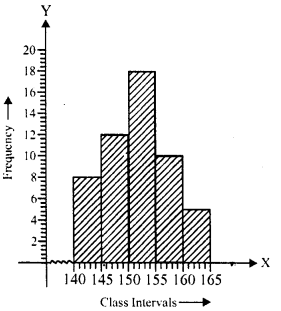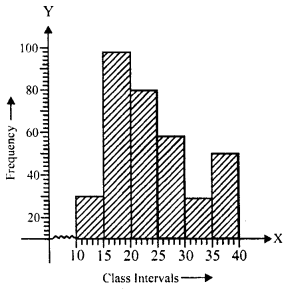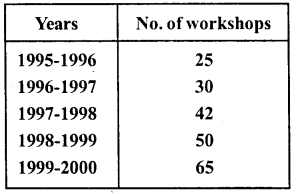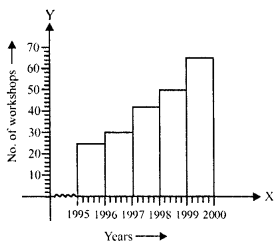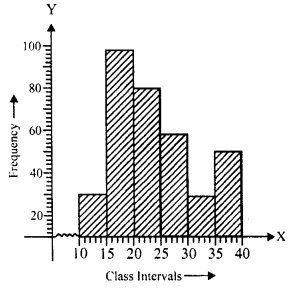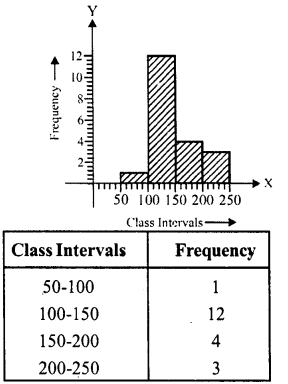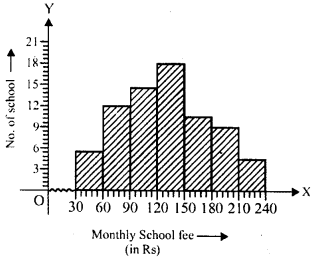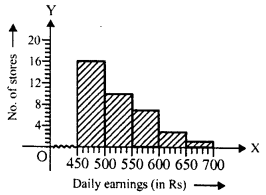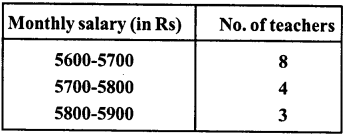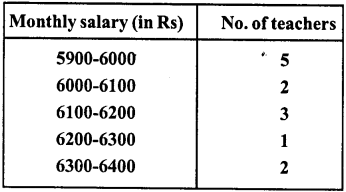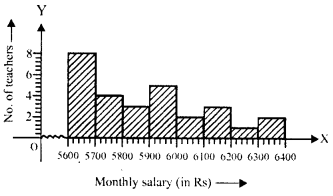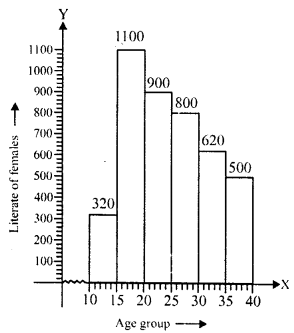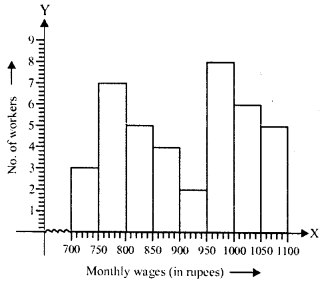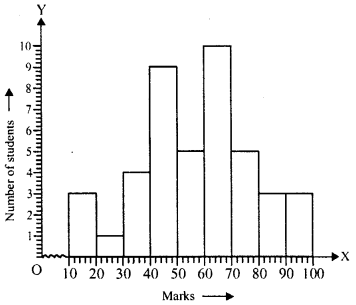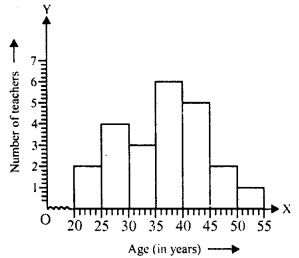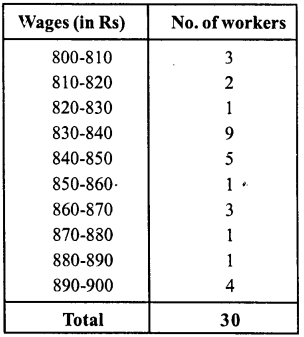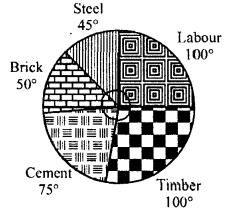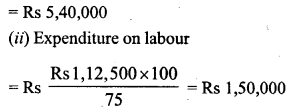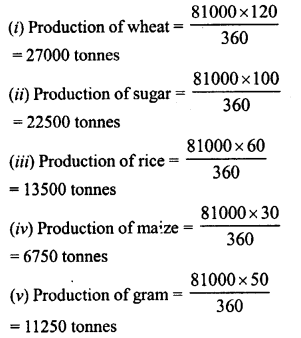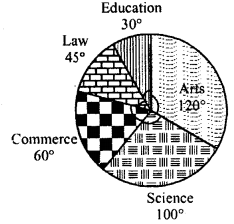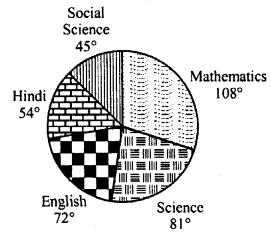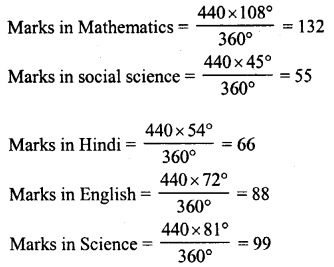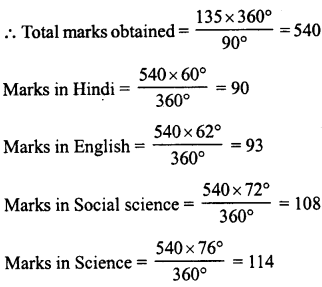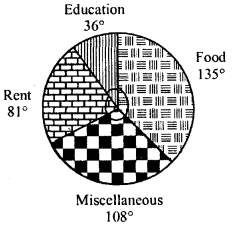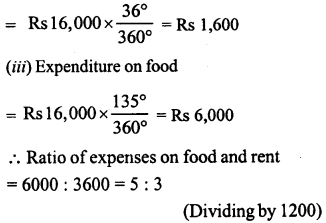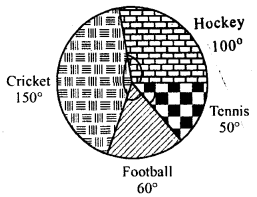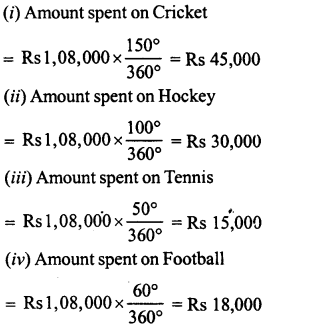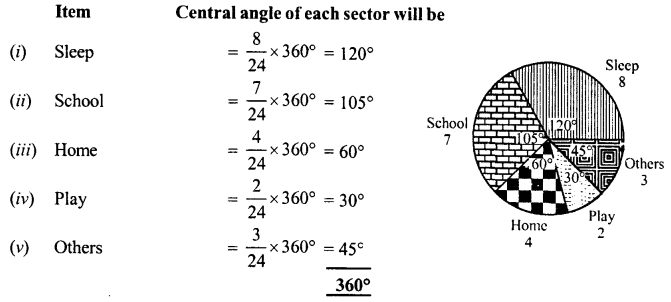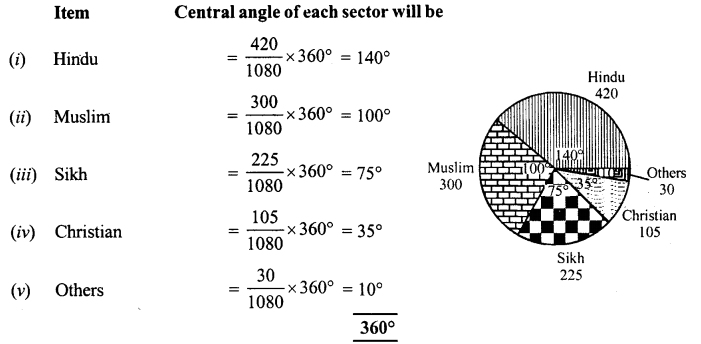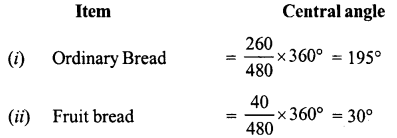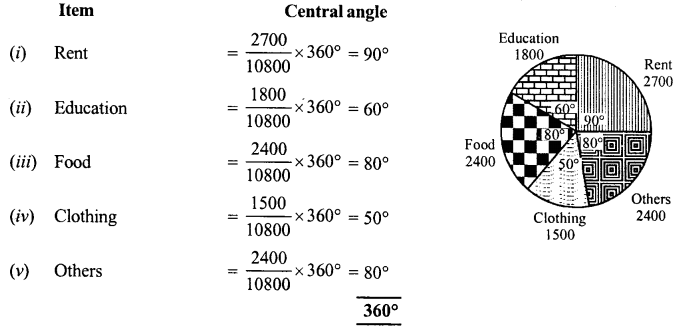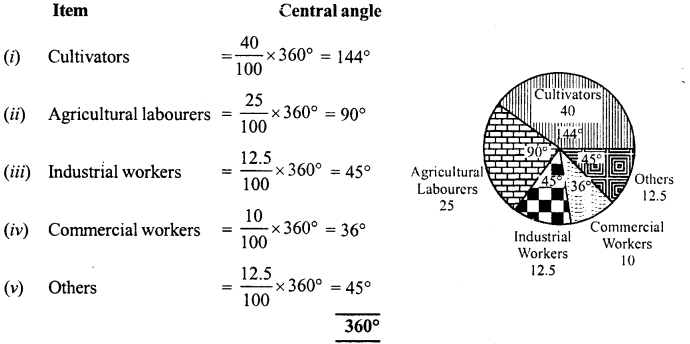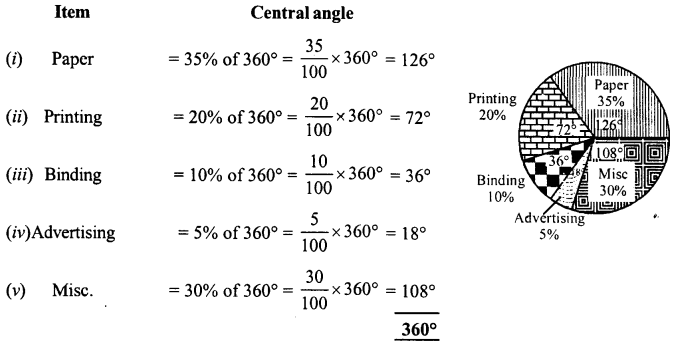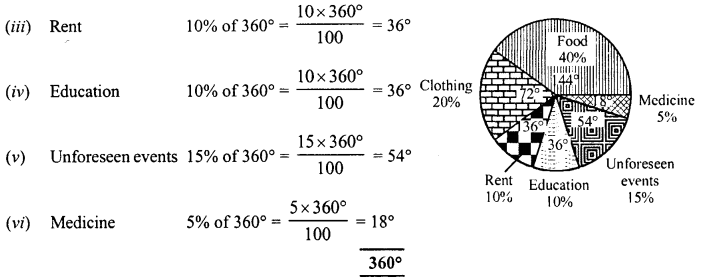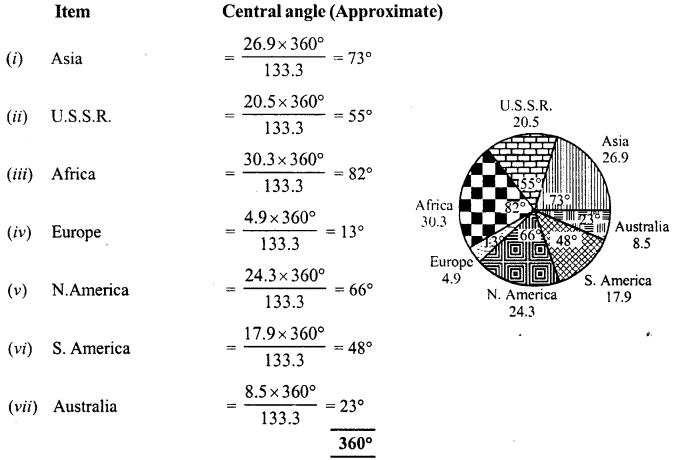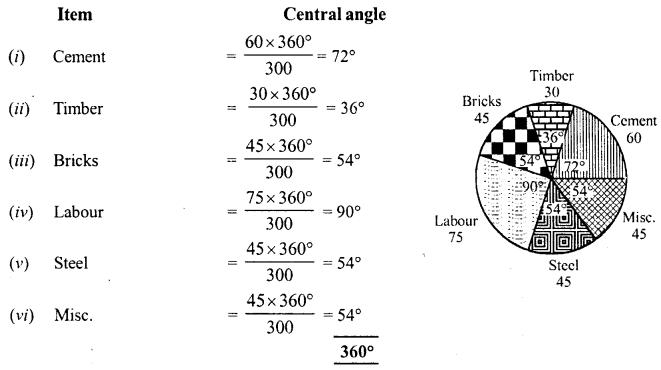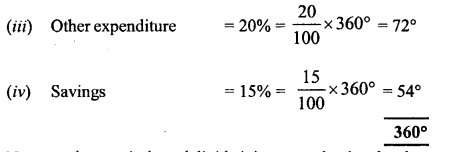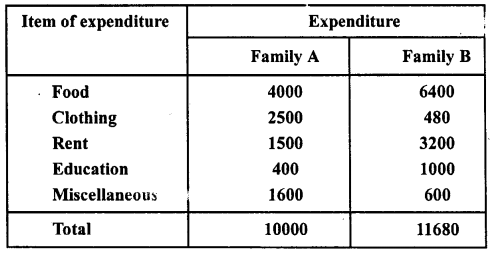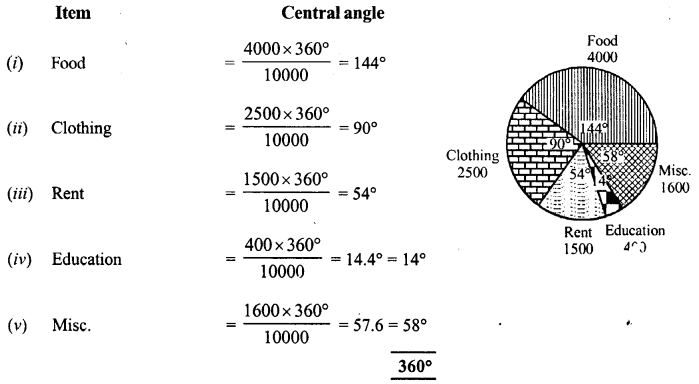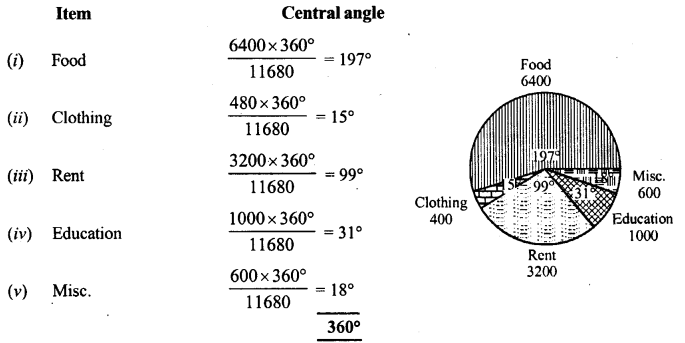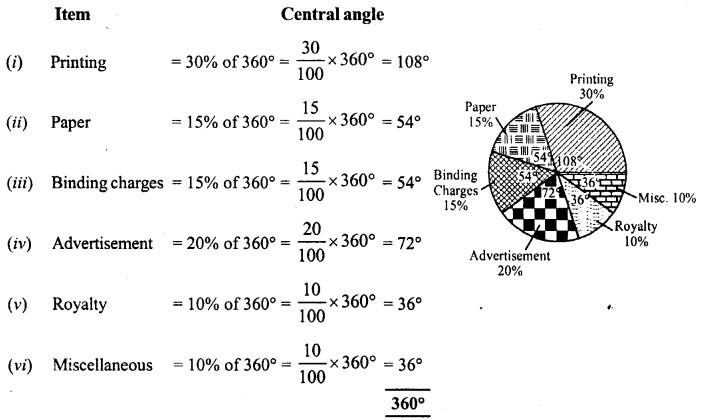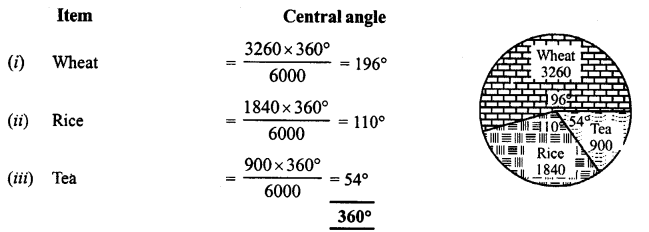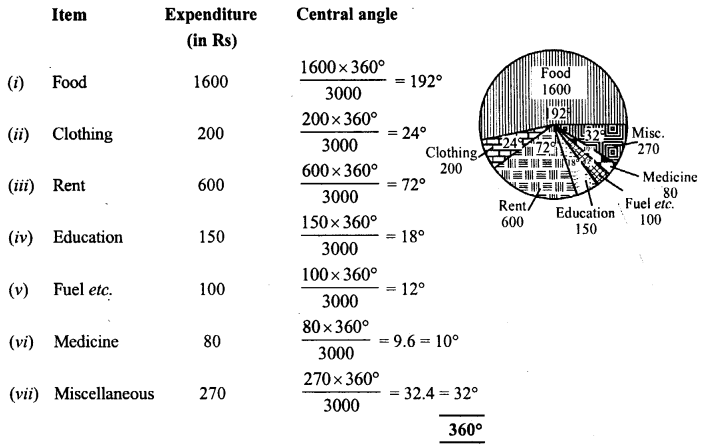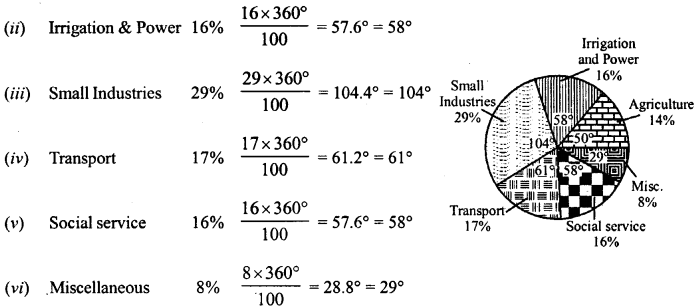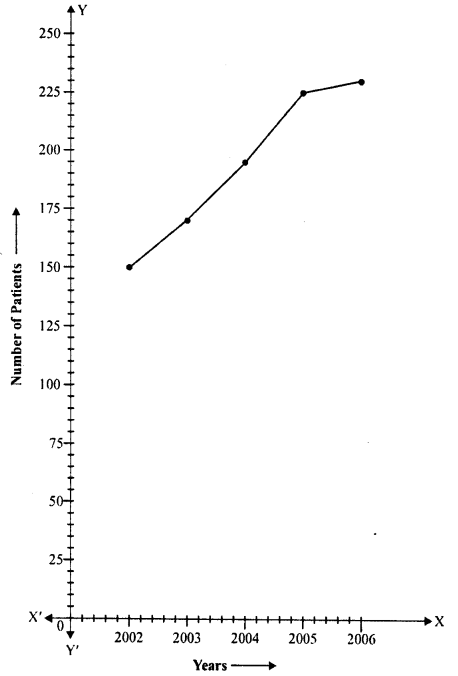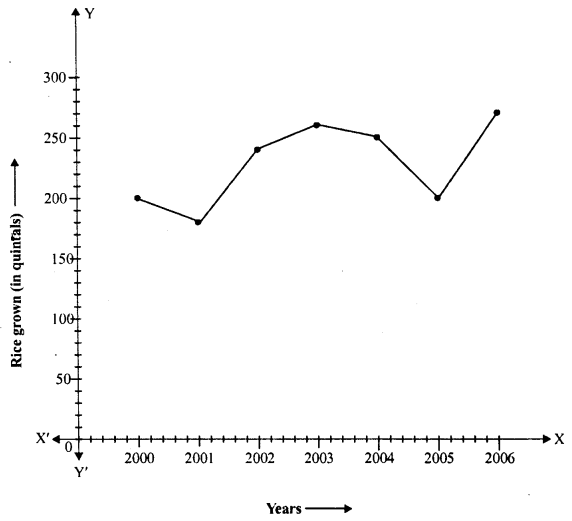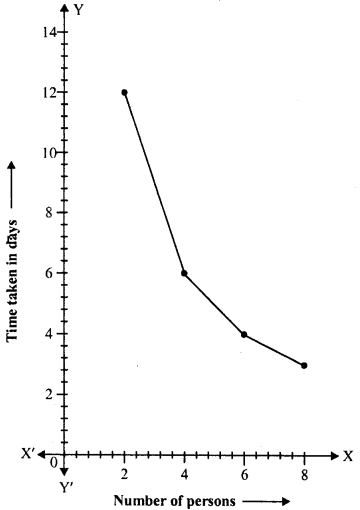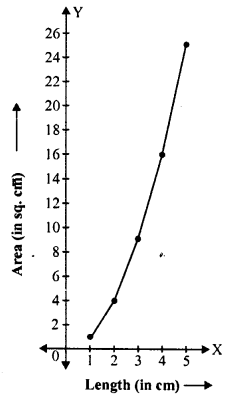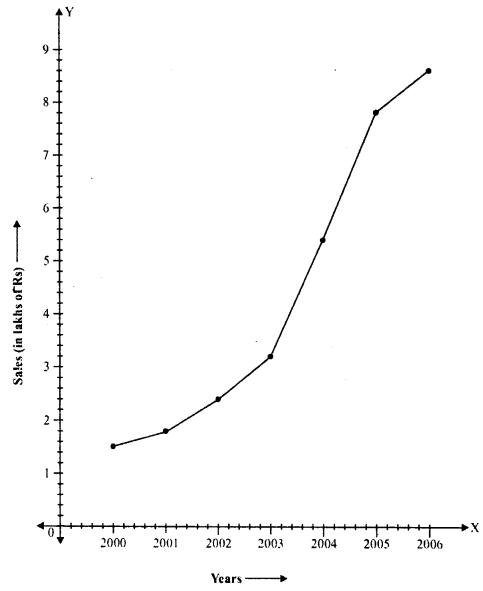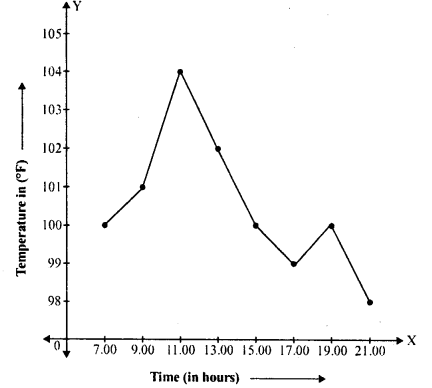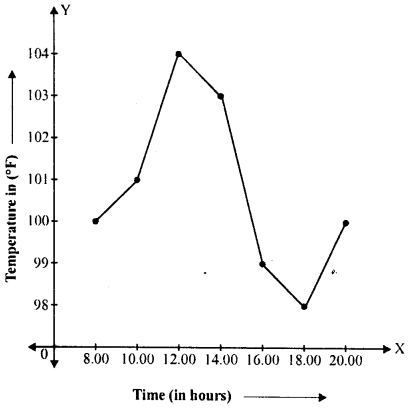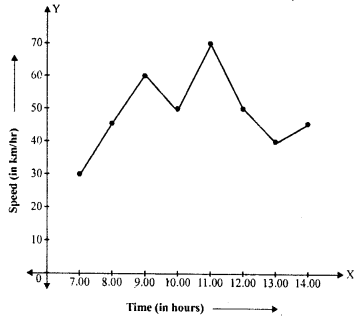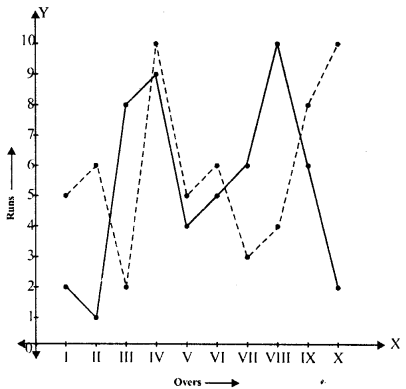RD Sharma Class 8 Solutions Chapter 26 Data Handling IV (probability) Ex 26.1
These Solutions are part of RD Sharma Class 8 Solutions. Here we have given RD Sharma Class 8 Solutions Chapter 26 Data Handling IV (probability) Ex 26.1
Question 1.
The probability that it will rain to morrow is 0.85. What is the probability that it will not rain tomorrow ?
Solution:
Total number of possible events = 1
∴ P (\(\bar { A }\) ) = 0.85
∴ P (\(\bar { A }\) ) = 1-0.85 = 0.15
Question 2.
A die is thrown. Find the probability of getting (i) a prime number (ii) 2 or 4 (iii) a multiple of 2 or 3.
Solution:
Total number of possible events = 6 (1 to 6)
(i) Let A be the favourable occurrence which are prime number i.e., 2,3,5
∴ P(A) = \(\frac { 3 }{ 6 }\) = \(\frac { 1 }{ 2 }\)
(ii) Let B be the favourable occurrence which are 2 or 4
∴ P(B) = \(\frac { 2 }{ 6 }\) = \(\frac { 1 }{ 3 }\)
(iii) Let C be the favourable occurrence which are multiple of 2 or 3 i.e., 2, 3, 4, 6.
∴ P(C) = \(\frac { 4 }{ 6 }\) = \(\frac { 2 }{ 3 }\)
Question 3.
In a simultaneous throw of a pair of dice, find the probability of getting:
(i) 8 as the sum
(ii) a doublet
(iii) a doublet, of prime numbers
(iv) a doublet of odd numbers
(v) a sum greater than 9
(vi) an even number on first
(vii) an even number on one and a multiple of 3 on the other
(viii) neither 9 nor 11 as the sum of the numbers on the faces
(ix) a sum less than 6
(x) a sum less than 7
(xi) a sum more than 7
(xii) at least once
(xiii) a number other than 5 on any dice.
Solution:
By throwing of a pair of dice, total number of possible events = 6 × 6 = 36
(i) Let A be the occurrence of favourable events whose sum is 8 i.e. (2,6), (3,5), (4,4), (5,3) , (6,2) which are 5
∴ P(A) = \(\frac { 5 }{ 36 }\)
(ii) Let B be the occurrence of favourable events which are doublets i.e. (1, 1), (2, 2), (3, 3), (4,4), (5, 5) and (6, 6).
∴ P(B) = \(\frac { 6 }{ 36 }\) = \(\frac { 1 }{ 6 }\)
(iii) Let C be the occurrence of favourable events which are doublet of prime numbers which are (2, 2), (3,3), (5, 5)
∴ P(C) = \(\frac { 3 }{ 36 }\) = \(\frac { 1 }{ 12 }\)
(iv) Let D be the occurrence of favourable events which are doublets of odd numbers which are (1, 1), (3, 3) and (5, 5)
∴ P(D) = \(\frac { 3 }{ 36 }\) = \(\frac { 1 }{ 12 }\)
(v) Let E be the occurrence of favourable events whose sum is greater than 8 i.e, (3,6), (4, 5), (4, 6), (5, 4), (5, 5), (5, 6) which are 6 in numbers
∴ P(E) = \(\frac { 6 }{ 36 }\) = \(\frac { 1 }{ 6 }\)
(vi) Let F be the occurrence of favourable events in which is an even number is on first i.e (2, 1), (2, 2), (2, 3), (2, 4), (2, 5), (2, 6), (4, 1),(4,2), (4,3) (4,4), (4,5), (4,6), (6,1), (6,2), (6, 3), (6,4 ), (6, 5), (6,6) which are 18 in numbers.
∴ P(F) = \(\frac { 18 }{ 36 }\) = \(\frac { 1 }{ 2 }\)
(vii) Let G be the occurrence of favourable events in which an even number on the one and a multiple of 3 on the other which are (2,3), (2,6), (4, 3), (4, 6), (6, 3), (6, 6), (3, 2), (3, 4), (3, 6), (6,2), (6,4) = which are 11th number
∴ P(G) = \(\frac { 11 }{ 36 }\)
(viii) Let H be the occurrence of favourable events in which neither 9 or 11 as the sum of the numbers on the faces which are (1,1), (1,2), (1,3) , (1, 4), (1, 5), (1, 6), (2, 1), (2, 2), (2, 3), (2,4) , (2, 5), (2, 6), (3, 1), (3, 2), (3, 3), (3, 4), (3,5) , (4, 1), (4, 2), (4, 3), (4, 4), (4, 6), (5, 1), (5,2), (5,3), (5,5), (6,1), (6,2), (6,4), (6,6) which are 30
∴ P(H) = \(\frac { 30 }{ 36 }\) = \(\frac { 5 }{ 6 }\)
(ix) Let I be the occurrence of favourable events, such that a sum less than 6, which are (1, 1), (1, 2), (1, 3), (1, 4), (2, 1), (2, 2), (2, 3), (3, 1), (3, 2), (4,1) which are 10
∴ P(I) = \(\frac { 10 }{ 36 }\) = \(\frac { 5 }{ 18 }\)
(x) Let J be the occurrence of favourable events such that a sum is less than 7, which are
(1.1) , (1,2), (1,3), (1,4), (1,5), (2, 1), (2, 2), (2, 3), (2, 4), (3, 1), (3, 2), (3, 3), (4, 1), (4, 2), (5.1) which are 15
∴ P(J) = \(\frac { 15 }{ 36 }\) = \(\frac { 5 }{ 6 }\)
(xi) Let K be the occurrence of favourable events such that the sum is more than 7, which are (2, 6), (3, 5), (3, 6), (4, 4), (4, 5), (4, 6), (5, 3), (5, 4), (5, 5), (5, 6), (6, 2), (6, 3), (6, 4), (6, 5), (6, 6) which 15
∴ P(K) = \(\frac { 15 }{ 36 }\) = \(\frac { 5 }{ 12 }\)
(xii) Let L be the occurrence of favourable events such that at least P (L) one is black card
∴ P(L) = \(\frac { 26 }{ 52 }\) = \(\frac { 1 }{ 2 }\)
(xiii) Let M is the occurrence of favourable events such that a number other than 5 on any dice which can be (1,1), (1,2), (1,3), (1,4), (1,6), (2, 1), (2, 2), (2, 3), (2, 4), (2, 6), (3,1), (3,2), (3, 3), (3,4), (3,6), (4,1), (4, 2), (4, 3), (4,4), (4,6), (6, 1), (6,2), (6, 3), (6,4), (6, 6) which are 25
∴ P(M) = \(\frac { 25 }{ 36 }\)
Question 4.
Three coins are tossed together. Find the probability of getting:
(i) exactly two heads
(ii) at least two heads
(iii) at least one head and one tail
(iv) no tails
Solution:
Total number of events tossed by 3 coins each having one head and one tail = 2x2x2 = 8
(i) Let A be the occurrence of favourable events which is exactly two heads, which can be 3 in number which are HTH, HHT, THH.
∴ P(A) = \(\frac { 3 }{ 8 }\)
(ii) Let B be the occurrence of favourable events which is at least two heads, which will be 4 which are HHT, HTH, THH, and HHH.
∴ P(B) = \(\frac { 4 }{ 8 }\) = \(\frac { 1 }{ 2 }\)
(iii) Let C be the occurrence 6f favourable events which is at least one head and one tail which are 6 which can be HHT, HTH, THH, TTH, THT, HTT
∴ P(C) = \(\frac { 6 }{ 8 }\) = \(\frac { 3 }{ 4 }\)
(iv) Let D be the occurrence of favourable events in which there is no tail which is only 1 (HHH)
∴ P(D) = \(\frac { 1 }{ 8 }\)
Question 5.
A card is drawn at random from a pack of 52 cards. Find the probability that the card drawn is:
(i) a black king
(ii) either a black card or a king
(iii) black and a king
(iv) a jack, queen or a king
(v) neither a heart nor a king
(vi) spade or an ace
(vii) neither an ace nor a king
(viii) neither a red card nor a queen
(ix) other than an ace
(x) a ten
(xi) a spade
(xii) a black card
(xiii) the seven of clubs
(xiv) jack
(xv) the ace of spades
(xvi) a queen
(xvii) a heart
(xviii) a red card
Solution:
A pack of cards have 52 cards, 26 black and 26 red and four kinds each of 13 cards from 2 to 10, one ace, one jack, one queen and one king.
∴ Total number of possible events = 52
(i) Let A be the occurrence of favourable events which is a black king which are 2.
∴ P(A) = \(\frac { 2 }{ 52 }\) = \(\frac { 1 }{ 26 }\)
(ii) Let B be the occurrence of favourable events such that it is either a black card or a king.
Total = number of black cards = 26 + 2 red kings = 28
∴ P(B) = \(\frac { 28 }{ 52 }\) = \(\frac { 7 }{ 13 }\)
(iii) Let C be the occurrence of favourable events such that it is black and a king which can be 2.
∴ P(C) = \(\frac { 2 }{ 52 }\) = \(\frac { 1 }{ 26 }\)
(iv) Let D be the occurrence of favourable events such that it is a jack, queen or a king which will be4 + 4 + 4 = 12
∴ P(D) = \(\frac { 12 }{ 52 }\) = \(\frac { 3 }{ 13 }\)
(v) Let E be the occurrence of favourable events such that it is neither a heart nor a king.
∴ Number of favourable event will be 13 x 3 -3 = 39 – 3 = 36
∴ P(E) = \(\frac { 36 }{ 52 }\) = \(\frac { 9 }{ 13 }\)
(vi) Let F be the occurrence of favourable events such that it is a spade or an ace.
∴ Number of events = 13 + 3 = 16
∴ P(F) = \(\frac { 16 }{ 52 }\) = \(\frac { 4 }{ 13 }\)
(vii) Let G be the occurrence of favourable events such that it neither an ace nor a king.
∴Number of events = 52 – 4 – 4 = 44
∴ P(G) = \(\frac { 44 }{ 52 }\) = \(\frac { 11 }{ 13 }\)
(viii) Let H be the occurrence of favourable events such that it is neither a red card nor a queen.
∴Number of events = 26 – 2 = 24,
∴ P(H) = \(\frac { 24 }{ 52 }\) = \(\frac { 6 }{ 13 }\)
(ix) Let 1 be the occurrence of favourable events such that it is other than an ace.
∴ Number of events = 52 – 4 = 48
∴ P(I) = \(\frac { 48 }{ 52 }\) = \(\frac { 12 }{ 13 }\)
(x) Let J be the occurrence of favourable event such that it is ten
∴ Number of events = 4
∴ P(J) = \(\frac { 4 }{ 52 }\) = \(\frac { 1 }{ 13 }\)
(xi) Let K be the occurrence of favourable event such that it is a spade.
∴ Number of events =13
∴ P(K) = \(\frac { 13 }{ 52 }\) = \(\frac { 1 }{ 4 }\)
(xii) Let L be the occurrence of favourable event such that it is a black card.
∴ Number of events = 26
∴ P(L) = \(\frac { 26 }{ 52 }\) = \(\frac { 1 }{ 2 }\)
(xiii) Let M be the occurrence of favourable event such that it is the seven of clubs.
∴ Number of events = 1
∴ P(M) = \(\frac { 1 }{ 52 }\)
(xiv) Let N be the occurrence of favourable event such that it is a jack.
∴ Number of events = 1
∴ P(N) = \(\frac { 4 }{ 52 }\) = \(\frac { 1 }{ 13 }\)
(xv) Let O be the occurrence of favourable event such that it is an ace of spades.
∴ Number of events = 1
∴ P(O) = \(\frac { 1 }{ 52 }\)
(xvi) Let Q be the occurrence of favourable event such that it is a queen.
∴ VNumber of events = 4
∴ P(P) = \(\frac { 4 }{ 52 }\) = \(\frac { 1 }{ 13 }\)
(xvii) Let R be the occurrence of favourable event such that it is a heart card.
∴ Number of events =13
∴ P(P) = \(\frac { 13 }{ 52 }\) = \(\frac { 1 }{ 4 }\)
(xviii) Let S be the occurrence of favourable event such that it is a red card
∴ Number of events = 26
∴ P(P) = \(\frac { 26 }{ 52 }\) = \(\frac { 1 }{ 2 }\)
Question 6.
An urn contains 10 red and 8 white balls. One ball is drawn at random. Find the probability that the ball drawn is white.
Solution:
Number of possible events = 10 + 8 = 18
Let A be the occurrence of favourable event such that it is a white ball.
∴ Number of events = 8
∴ P(A) = \(\frac { 8 }{ 18 }\) = \(\frac { 4 }{ 9 }\)
Question 7.
A bag contains 3 red balls, 5 black balls and 4 white balls. A ball is drawn at random from the bag. What is the probability that the ball drawn is (i) white ? (ii) red ? (iii) black ? (iv) not red ?
Solution:
Number of possible events = 3 + 5 + 4 = 12 balls
(i) Let A be the favourable event such that it is a white ball.
∴ P(A) = \(\frac { 4 }{ 12 }\) = \(\frac { 1 }{ 3 }\)
(ii) Let B be the favourable event such that it is a red ball.
∴ P(B) = \(\frac { 3 }{ 12 }\) = \(\frac { 1 }{ 4 }\)
(iii) Let C be the favourable event such that it is a black ball.
∴ P(C) = \(\frac { 5 }{ 12 }\)
(iv) Let D be the favourable event such that it is not red.
∴ Number of favourable events = 5 + 4 = 9
∴ P(D) = \(\frac { 9 }{ 12 }\) = \(\frac { 3 }{ 4 }\)
Question 8.
What is the probability that a number selected from the numbers 1,2,3,…………, 15 is a multiple of 4 ?
Solution:
Number of possible events =15
Let A be the favourable event such that it is a multiple of 4 which are 4, 8, 12
∴ P(A) = \(\frac { 3 }{ 15 }\) = \(\frac { 1 }{ 5 }\)
Question 9.
A bag contains 6 red, 8 black and 4 white balls. A ball is drawn at random. What is the probability that ball drawn is not black ?
Solution:
Number of possible events = 6 + 8 + 4 = 18 balls
Let A be the favourable event such that it is not a black
∴ Number of favourable events = 6 + 4=10
∴ P(A) = \(\frac { 10 }{ 18 }\) = \(\frac { 5 }{ 9 }\)
Question 10.
A bag contains 5 white and 7 red balls. One ball is drawn at random, what is the probability that ball drawn is white ?
Solution:
Number of possible events = 5 + 7 = 12
Let A be the favourable event such that it is a while which are 5.
∴ P(A) = \(\frac { 5 }{ 12 }\)
Question 11.
A bag contains 4 red, 5 black and 6 white balls. A ball is drawn from the bag at random. Find the probability that the ball drawn is (i) white (if) red (iii) not black (iv) red or white.
Solution:
Number of possible events = 4 + 5 + 6 = 15
(i) Let A be the favourable events such that it is a white.
∴ P(A) = \(\frac { 6 }{ 15 }\) = \(\frac { 2 }{ 5 }\)
(ii) Let B be the favourable event such that it is a red
∴ P(B) = \(\frac { 4 }{ 15 }\)
(iii) Let C be the favourable event such that it is not black.
∴ Number of favourable events = 4 + 6=10
∴ P(C) = \(\frac { 10 }{ 15 }\) = \(\frac { 2 }{ 3 }\)
Question 12.
A bag contains 3 red balls and 5 black balls. A ball is drawn at random from the bag. What is the probability that the ball drawn is: (i) red (ii) black.
Solution:
Number of possible events = 3 + 5 = 8
(i) Let A be the favourable events such that it is red.
∴ P(A) = \(\frac { 3 }{ 8 }\)
(ii) Let B be the favourable event such that it is black.
∴ P(B) = \(\frac { 5 }{ 8 }\)
Question 13.
A bag contains 5 red marbles, 8 white marbles, 4 green marbles. What is the probability that if one marble is taken out of the bag at random, it will be
(i) red
(ii) white
(iii) not green.
Solution:
Total number of possible events = 5 + 8+4=17
(i) Let A be the favourable event such that it is red.
∴ P(A) = \(\frac { 5 }{ 7 }\)
(ii) Let B be the favourable event such that it is white
Then P (B) = \(\frac { 8 }{ 7 }\)
(iii) Let C be the favourable event such that it is not green.
∴ Number of favourable events = 5 + 8 = 13
∴ P(C) = \(\frac { 13 }{ 17 }\)
Question 14.
If you put 21 consonants and 5 vowels in a bag. What would carry greater probability ? Getting a consonant or a vowel ? Find each probability.
Solution:
Total number of possible events = 21 + 5 = 26
(i) Probability of getting a consonant is greater as to number is greater than the other.
(ii) Let A be the favourable event such that it is a consonant.
∴ P(A) = \(\frac { 21 }{ 26 }\)
(iii) Let B be the favourable event such that it is a vowel.
∴ P(B) = \(\frac { 5 }{ 26 }\)
Question 15.
If we have 15 boys and 5 girls in a class which carries a higher probability ? Getting a copy belonging to a boy or a girl ? Can you give it a value ?
Solution:
Number of possible outcome (events) = 15 + 5 = 20
∵ The number of boys is greater than the girls
∴ The possibility of getting a copy belonging to a boy is greater.
Let A be the favourable outcome (event) then
P(A) = \(\frac { 15 }{ 20 }\) = \(\frac { 3 }{ 4 }\)
Question 16.
If you have a collection of 6 pairs of white socks and 3 pairs of black socks. What is the probability that a pair you pick without looking is (i) white ? (if) black ?
Solution:
Total number of possible outcomes =6+3=9
(i) Let A be the favourable outcome which is white pair.
∴ P(A) = \(\frac { 6 }{ 9 }\) = \(\frac { 2 }{ 3 }\)
(ii) Let B be the favourable outcome which is a black pair.
∴ P(B) = \(\frac { 3 }{ 9 }\) = \(\frac { 1 }{ 3 }\)
Question 17.
If you have a spinning wheel with 3 green sectors, 1-blue sector and 1-red sector, what is the probability of getting a green sector ? Is it the maximum ?
Solution:
Total number of possible outcomes = 3 + 1 + 1 =5
Let A be the favourable outcome which is green sector
∴ P(A) = \(\frac { 3 }{ 5 }\)
∴ Number of green sectors is greater.
∴ It’s probability is greater.
Question 18.
When two dice are rolled :
(i) List the outcomes for the event that the total is odd.
(ii) Find probability of getting an odd total.
(iii) List the outcomes for the event that total is less than 5.
(iv) Find the probability for getting a total less than 5.
Solution:
∵ Every dice has 6 number from 1 to 6.
∴ Total outcomes = 6 x 6 = 36.
(i) List of outcomes for event then the total is odd will be (1,2), (1,4), (1,6), (2,1), (2, 3), (2, 5), (3, 2), (3, 4), (3, 6), (4, 1), (4, 3), (4, 5), (5, 2), (5, 4), (5, 6), (6,1), (6, 3), (6, 5)
(ii) Probability of getting an odd total
Let A be the favourable outcomes which are
P(A) = \(\frac { 18 }{ 36 }\) = \(\frac { 1 }{ 2 }\)
(iii) List of outcomes for the event that total is less than 5 are (1, 1), (1, 2), (1, 3), (2, 1), (2, 2), (2,1), which are 6.
(iv) Probability of getting a total less than 5 Let B be the favourable outcome,
Then P (B) = \(\frac { 6 }{ 36 }\) = \(\frac { 1 }{ 6 }\)
Hope given RD Sharma Class 8 Solutions Chapter 26 Data Handling IV (probability) Ex 26.1 are helpful to complete your math homework.
If you have any doubts, please comment below. Learn Insta try to provide online math tutoring for you.

